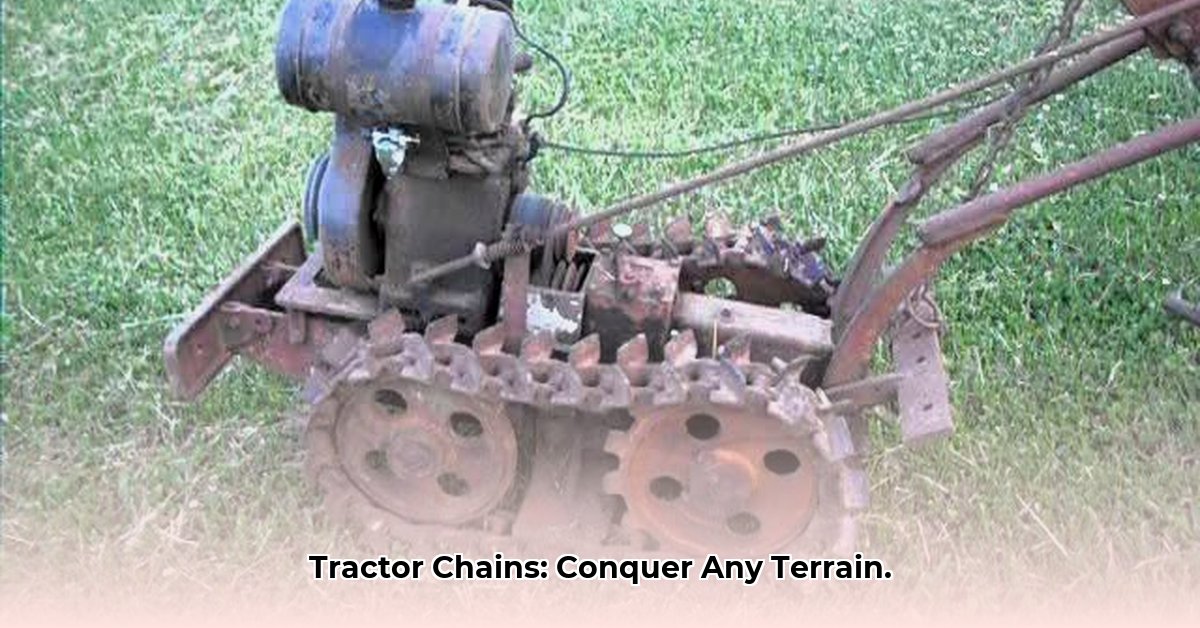
Choosing the right tractor tire chains can significantly impact your farm's efficiency and safety. This guide provides a step-by-step approach to selecting, installing, and maintaining chains for optimal traction in various conditions. Don't let challenging terrain slow you down; learn how to maximize your traction today. For more detailed information on specific chain types, check out this helpful resource: tractor chains guide.
Understanding Tractor Tire Chains
Several types of tractor tire chains cater to different needs and terrains. Understanding their characteristics is crucial for making the right choice.
Types of Tractor Tire Chains
Each chain type offers unique advantages and disadvantages:
Twist Link Ladder Chains: These are the most common and affordable option. They provide adequate traction in light snow, mud, and ice but may lack grip in extreme conditions. Think of them as your all-around workhorse.
DUO Chains: Featuring two chains linked together, DUO chains offer superior grip on ice and snow compared to twist link ladder chains. While more expensive, they provide enhanced safety in slippery conditions.
Double Ring Chains: Designed for heavy-duty applications, these chains excel in thick mud and deep snow. Their robust construction ensures durability but can be harder on paved surfaces. They represent a significant investment.
V-Bar Chains: Ideal for packed snow and icy patches, V-bar chains' unique design bites into the surface for increased traction. However, they are less effective in deep mud or loose snow.
Studded Chains: Reserved for extreme conditions (blizzard-like snow or severely icy roads), studded chains provide unmatched traction thanks to their metal studs. However, they can damage paved surfaces and are the most expensive option. Use them only when absolutely necessary.
The following table summarizes the key features of each chain type:
| Chain Type | Pros | Cons | Best Suited For |
|---|---|---|---|
| Twist Link Ladder | Affordable, good all-around traction | Less grip in extreme conditions | Light snow, mud, and ice conditions |
| DUO | Excellent ice and snow traction | More expensive than twist link ladder | Icy and snowy conditions |
| Double Ring | Superior mud and snow traction, durable | More expensive, may damage paved surfaces | Heavy mud and deep snow |
| V-Bar | Excellent traction on packed snow/ice | Less effective in deep mud or loose snow | Packed snow and icy patches |
| Studded | Unmatched extreme-condition traction | Potential for road damage, very expensive | Extreme snow and ice; use with extreme caution |
Choosing the Right Chains: A Step-by-Step Guide
Selecting the appropriate chains involves careful consideration of several factors:
Measure Your Tires: Accurately measure your tractor's tire width and diameter. Consult your tractor's manual for precise measurement instructions. Incorrect sizing can lead to improper fit and reduced effectiveness. (Why is accurate measurement so crucial? Because incorrectly sized chains won't fit properly, jeopardizing safety and traction.)
Assess Terrain Conditions: Identify the typical surfaces you'll be traversing (mud, snow, ice, packed snow). The type of terrain directly impacts chain selection. (What are the most common terrain challenges you face on your farm?)
Define Your Budget: Tire chains vary significantly in price. Consider the balance between performance and cost. (How does your budget affect your choice of chain type and material?)
Consult Your Tractor's Manual: Your tractor's manual may offer specific recommendations for tire chain selection and installation. Always prioritize the manufacturer's guidelines.
Select the Appropriate Chains: Based on your tire measurements, terrain assessment, budget, and tractor manual recommendations, choose the optimal chain type and size.
Installing and Maintaining Tractor Tire Chains
Proper installation and maintenance are crucial for both safety and chain longevity.
Installation
Prepare Your Tractor: Park on a level surface with the brakes engaged. Safety is paramount.
Position the Chains: Carefully place the chains around the tires, ensuring proper alignment.
Fasten the Chains: Securely connect the chains using the provided clasps or hooks.
Tighten the Chains: Adjust the chains to ensure a snug fit without excessive tightness. Maintain some slack for flexibility.
Test Drive: Perform a short test drive to verify correct installation and functionality. Adjust as needed.
Maintenance
Regular Inspection: Inspect chains before each use for any wear or damage. Replace damaged sections immediately.
Cleaning: Clean chains after each use to remove mud, dirt, and debris. This prevents rust and corrosion.
Storage: Store chains in a dry, clean location when not in use.
Troubleshooting Common Issues
Occasionally, you may encounter problems with tractor tire chains. Here are some common issues and solutions:
Chains slipping: Ensure chains are properly tightened and adjusted. Consider using chains designed for your specific terrain.
Chains breaking: Regularly inspect chains for signs of wear and tear. Replace damaged segments immediately.
Difficulty installing chains: Consult your tractor manual for proper installation instructions. Consider seeking assistance from an experienced professional if needed.
Conclusion
Selecting and using the right tractor tire chains is essential for maximizing traction, ensuring safety, and preserving equipment longevity. By following the steps outlined in this guide, farmers can optimize their operations and navigate challenging conditions with confidence. Remember to always consult with your equipment supplier for personalized recommendations. Remember, proper chain maintenance is key to extending their lifespan and preventing costly repairs down the road.